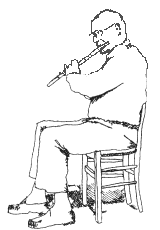BY MICHEL DEBOST

Drawings courtesy Jeanne Roth 
Jutting the chin creates unnecessary tension in Atlas/axis vertebrae 
|
Even before the first phrase is finished a performer's awkward posture impresses an audience. A stilted posture with the head, elbows, and
chin held too high is not comfortable or recommended. When standing before playing, imagine that you are reading a magazine on the
music stand or a notice on a bulletin board. Then bring the flute up to the lips without raising the shoulders or elbows. When the elbows
are held too high, cocked wrists, fatigue, and nerve strain result; if the shoulders are held too high, the throat and air column become
choked.
An optimal posture involves the shoulders in alignment with the elbows. To accomplish this a flutist will have to turn his head laterally about 30 degrees, but this is better than pushing the right elbow out of alignment with the shoulder. Although few flutists consider posture involving anything below the waist, the legs can provide support. The action of lifting a suitcase, for example, uses leg muscles, while at the same time, abdominal muscles contract. Try lifting a suitcase to feel body support and concentrate on leg and abdominal muscle function. When actually playing, stand with both feet planted comfortably on the floor to support the body weight, as if pushing the ground away. Some occasional body motion and shifting the feet gracefully help convey the mood of the performance while relieving some of the physical tension. The straight-legged picket fence stance can be too stiff, but try to find a posture that centers on awareness of gravity, even during agitated passages. An appropriate posture also applies when sitting: elbows and shoulders should be low. The military posture of holding the chin up with the back straight, sitting on the edge of the chair with the knees together, is too stiff for flute playing. Comfort is the issue. While seated the knees should be about a foot apart, and female players should not wear short skirts. (Ask any female cellist or harpist. ) Players should look nice, especially for public performances, yet a concert is not a fashion show. Pants that are not too tight can be elegant; nothing a player wears should distract listeners from the music. Performers such as Nadia Salerno-Sonnenberg have found that too extraordinary is just as unappealing as too laid back. When players sit in an ensemble, the chair should not be exactly at right angles to the body, but turned slightly to the right so that the head turns toward the left elbow. This position allows the right elbow to be in a normal alignment with the chest without creating a strained posture. The flute should face the conductor and the public, not the body's posterior or the chair. While standing or sitting too erect is detrimental to playing, slouching is just as bad; however, using a low back support is beneficial as long as it does not cause a player to slouch. I prefer spending my energy on playing than on sitting erect. Not all chairs are comfortable, and when possible, try to find a chair with a stiff seat and low back. A chamber music or orchestral performance entails sitting. When seated, try to feel the flank of the back against the lower part of the chair back, and push the stomach out for support. The feet should be firmly planted on the ground to complement the support. The energy should be directed to produce music, not toward appearance. I remember playing sessions with the jazz trumpeter Skitch Henderson, who rested his upper body against the back of the chair so all his energy could be directed into playing fantastic licks. Although many flutists bob their heads, no movement of the head or face should help the embouchure fetch a note as if it were a foreign object. Remember, the instrument comes to the lips without a player changing head position. The flute rests on the chin with firm contact, and the pressure is provided by the left forearm muscles via the first joint of the left index finger. Because playing comfort and efficiency depend on body equilibrium, it is important to gain a sense of balance in which the body energy is evenly distributed. |